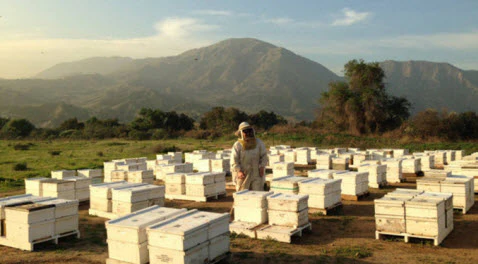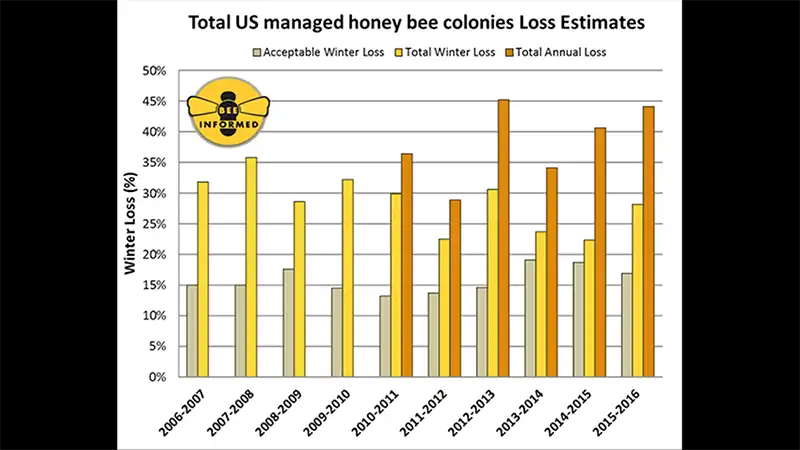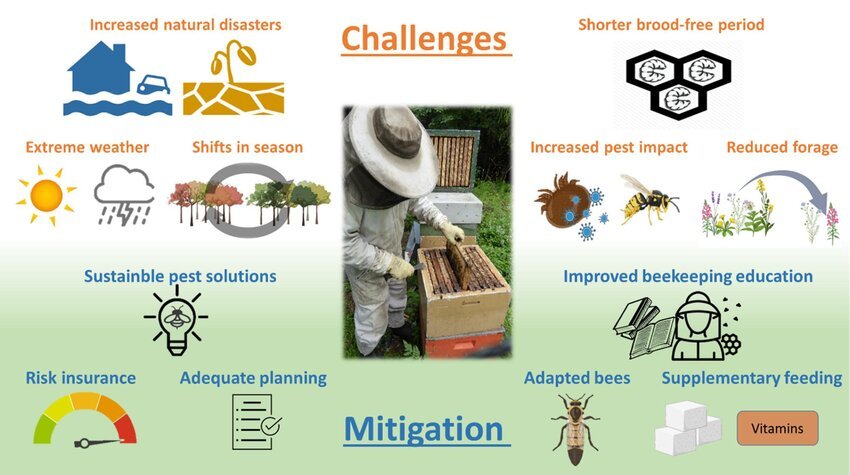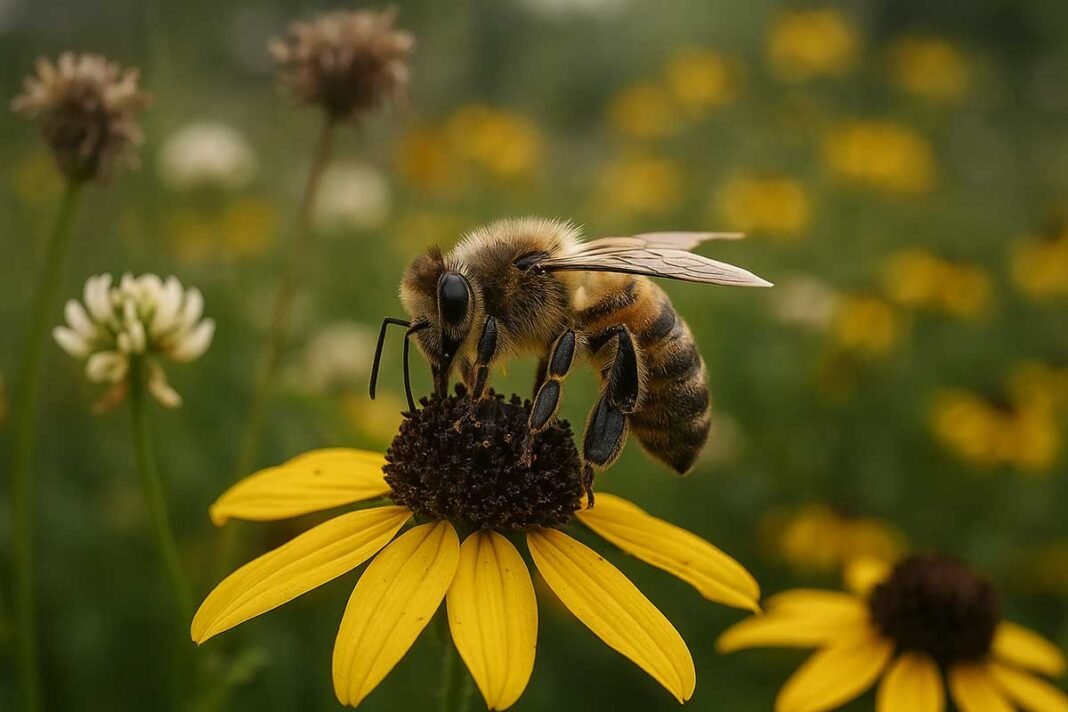My wife and I are urban beekeepers with 3 hives that keep us and friends and family in honey most years. As I write we are sadly having to treat our bees for Varroa Mite. Still, we are determined to do what we can to support these most impressive Bee Beings at a time when they face multiple threats to survival. You can download a copy of this essay at the bottom. – Kevin Parker Site Publisher
How the World’s Most Important Insects Face Unprecedented Threats to Their Survival
In the early morning hours of a California almond orchard, millions of white blossoms depend on a miracle of nature that has sustained life on Earth for over 100 million years. As honeybees emerge from their hives to begin their daily work, they participate in one of the planet’s most crucial ecological processes: pollination. Yet across the United States, beekeepers are waking up to a devastating reality—their colonies are disappearing at rates never before recorded in modern history.
Commercial beekeepers reported losing an average of 62% of their honeybee colonies between June 2024 and February 2025, representing the catastrophic loss of approximately 1.1 million colonies nationwide.¹ Scientists at Washington State University project that losses could reach 70% in 2025, marking the worst bee population crisis since systematic record-keeping began.² This unprecedented decline signals not just an agricultural emergency, but an ecological catastrophe that threatens the foundation of global food systems and biodiversity.

The Ecological Cornerstone
Bees occupy a position in Earth’s ecosystems that far exceeds their modest size. These insects, numbering over 20,000 species worldwide, serve as nature’s primary pollinators, facilitating the reproduction of approximately 90% of wild flowering plants and 75% of global food crops.³ The United Nations estimates that pollinators contribute roughly $500 billion annually to global food production, with bees representing the most economically valuable group within this critical cohort.⁴
The pollination process itself represents one of evolution’s most elegant partnerships. As bees collect nectar and pollen for their own survival, they inadvertently transfer genetic material between flowers, enabling plant reproduction and genetic diversity. This ancient collaboration has shaped terrestrial ecosystems, creating the flower-rich landscapes that support countless other species, from birds and mammals to other insects and microorganisms.
Beyond their role in agriculture, bees serve as keystone species in natural ecosystems. Research indicates that pollinator diversity enhances ecosystem resilience during environmental perturbations, helping plants maintain reproductive success even during periods of climate stress.⁵ In forests, grasslands, and other wild habitats, bees support the reproduction of native plants that provide food and shelter for wildlife, maintain soil stability, and contribute to carbon sequestration.
The economic impact of bee pollination extends far beyond honey production. In the United States alone, honey bees provide pollination services valued between $15-20 billion annually.⁶ Crops ranging from almonds and apples to coffee and cocoa depend heavily on bee pollination, with some agricultural systems requiring the coordinated movement of millions of hives across vast distances to ensure adequate pollination during critical blooming periods.
The Anatomy of Decline
The current bee crisis represents the convergence of multiple environmental stressors, each amplifying the others in what scientists describe as a “perfect storm” of ecological pressure. Unlike historical fluctuations in bee populations, today’s decline is characterized by its global scope, rapid pace, and multifaceted causation.
Habitat loss stands as perhaps the most fundamental driver of bee decline. Agricultural intensification has transformed diverse landscapes into monoculture crop systems, eliminating the wildflower meadows, hedgerows, and forest edges that historically provided year-round forage for bee populations.⁷ Urban development further fragments remaining habitats, creating isolated patches of suitable environment that cannot support sustainable bee populations.

The widespread application of synthetic pesticides, particularly neonicotinoids, has created toxic landscapes for pollinators. These systemic insecticides accumulate in plant tissues, including nectar and pollen, exposing bees to sub-lethal doses that impair navigation, memory, and immune function.⁸ Even when not immediately fatal, pesticide exposure weakens colonies, making them more susceptible to other stressors.
Climate change compounds these challenges through multiple pathways. Rising temperatures disrupt the synchronization between plant flowering times and bee emergence, creating temporal mismatches that can leave bees without adequate food sources during critical periods.⁹ Extreme weather events, including prolonged droughts and severe storms, directly impact both bee survival and the flowering plants they depend upon.
Parasites and pathogens represent another critical threat vector. The Varroa destructor mite, an external parasite that feeds on bee blood, has spread globally and serves as a vector for multiple viral diseases.¹⁰ Recent surveys indicate that these mites, along with emerging pathogens like Lotmaria passim and Nosema species, contribute significantly to colony collapse and reduced bee lifespan.
Perhaps most alarming is the emergence of what researchers term “multiple stressor interactions,” where the combined impact of these factors exceeds the sum of their individual effects. A colony weakened by pesticide exposure becomes more vulnerable to disease, while habitat loss forces bees to travel greater distances for food, increasing their energy expenditure and exposure to environmental toxins.
Geographic Variations in Crisis
While bee decline represents a global phenomenon, its manifestation varies significantly across different regions, revealing important insights about causation and potential solutions. The crisis is most acute in North America and parts of Europe, where industrial agriculture and urbanization have most dramatically altered landscapes.
In the United States, the situation has reached critical proportions. Commercial beekeepers, who manage the majority of the country’s honey bee colonies, face an existential crisis as colony losses consistently exceed sustainable levels.¹¹ The economic implications extend beyond beekeeping operations to affect entire agricultural sectors, with almond production in California serving as a particularly stark example of agriculture’s dependence on bee pollination.
Conversely, some regions demonstrate that bee population decline is not inevitable. Several Asian countries, including China and India, have experienced growth in managed bee populations over recent decades.¹² This divergence reflects differences in agricultural practices, landscape management, and conservation policies, suggesting that targeted interventions can successfully support bee populations.
The regional variation in bee decline also highlights the importance of native species conservation. While much attention focuses on managed honeybee populations, native bee species often face even greater threats. North America’s bumble bee populations have experienced particularly severe declines, with species like the rusty patched bumble bee now listed under the Endangered Species Act.¹³
Consequences for Global Ecosystems
The implications of widespread bee decline extend far beyond agricultural production to encompass fundamental changes in ecosystem structure and function. As pollinator networks collapse, plant communities face reproductive failure, leading to cascading effects throughout food webs.
In natural ecosystems, the loss of bee diversity reduces the resilience of plant communities to environmental stress. Research demonstrates that diverse pollinator assemblages provide more stable pollination services than simplified communities dominated by few species.¹⁴ As bee populations decline and lose diversity, plant communities become increasingly vulnerable to additional stressors, potentially triggering ecosystem collapse.
The agricultural consequences of bee decline manifest through both reduced crop yields and decreased food quality. Many fruits and vegetables exhibit poor formation, reduced seed production, and diminished nutritional content when inadequately pollinated.¹⁵ These effects not only reduce farm productivity but also contribute to global food insecurity and malnutrition, particularly affecting populations that depend heavily on pollinator-dependent crops.
Beyond immediate agricultural impacts, bee decline threatens the maintenance of genetic diversity in wild plant populations. Effective pollination facilitates gene flow between plant populations, maintaining the genetic variation necessary for adaptation to changing environmental conditions.¹⁶ As pollination networks collapse, plant populations become increasingly isolated and genetically impoverished, reducing their long-term evolutionary viability.
Conservation Responses and Solutions
Despite the severity of the crisis, emerging conservation strategies offer hope for bee population recovery. Habitat restoration has proven particularly effective, with studies demonstrating significant increases in bee abundance and diversity following the establishment of flower-rich environments.¹⁷
Urban areas present unexpected opportunities for bee conservation. Cities and suburbs can support surprisingly diverse bee communities when appropriate habitat is provided, with research showing that urban bee biodiversity can rival that of agricultural landscapes.¹⁸ Initiatives ranging from pollinator gardens in parks to “bee-friendly” building requirements demonstrate the potential for human-dominated landscapes to contribute to conservation goals.

Agricultural practices are also evolving to better support pollinators. Integrated pest management approaches reduce reliance on harmful pesticides, while diversified farming systems that incorporate flower strips, hedgerows, and cover crops provide additional forage and nesting opportunities for bees.¹⁹ Some progressive farming operations have demonstrated that pollinator-friendly practices can enhance both bee populations and crop productivity.
Policy interventions at various scales contribute to conservation efforts. The European Union’s restrictions on neonicotinoid pesticides represent a significant step toward reducing chemical threats to pollinators, while initiatives like the United States’ National Pollinator Strategy provide frameworks for coordinated conservation action.²⁰ Local governments have also implemented innovative programs, from pesticide-free zones to requirements for pollinator habitat in new developments.
Citizen science and community engagement have emerged as powerful tools for both conservation and monitoring. Programs that engage volunteers in bee surveys, habitat creation, and policy advocacy multiply the capacity of professional conservationists while building public support for pollinator protection.²¹ These grassroots efforts prove particularly important given the scale of habitat needed to support sustainable bee populations.
The Path Forward
The bee crisis demands urgent, coordinated action across multiple sectors and scales. Scientific research continues to refine understanding of bee ecology and conservation needs, while technological innovations offer new tools for monitoring and protecting populations. From precision agriculture techniques that minimize pesticide exposure to advanced breeding programs that develop disease-resistant bee strains, human ingenuity is beginning to address the complex challenges facing pollinators.
However, technological solutions alone cannot resolve the fundamental ecological disruptions that drive bee decline. Successful conservation requires landscape-scale changes that restore the diverse, flower-rich habitats that historically supported abundant bee populations. This transformation demands not only scientific knowledge and technical expertise but also social and political commitment to prioritize long-term ecological health over short-term economic gains.
The window for action remains open, but it is rapidly closing. Current trends suggest that without significant intervention, many bee species face local or regional extinction within decades. Yet the examples of successful conservation efforts, from restored prairies teeming with native bees to urban gardens that support surprising pollinator diversity, demonstrate that recovery is possible when human activities align with ecological needs.
As research continues to reveal the intricate connections between bees, plants, and entire ecosystems, one truth becomes increasingly clear: the fate of these small insects is inextricably linked to the health of our planet. Their survival requires not just the protection of individual species, but the restoration of the ecological relationships that have sustained life on Earth for millions of years. In saving the bees, we ultimately save ourselves.
Download a copy of ‘The Ecological Crisis of Bee Decline: Nature’s Pollinators at the Brink’ with my complements – Kevin Parker Ed
Bibliography
Belsky, Jess, and Neelendra K. Joshi. “Impact of Biotic and Abiotic Stressors on Managed and Feral Bees.” Insects 10, no. 8 (2019): 233.
Buchmann, Stephen L., and Gary Paul Nabhan. The Forgotten Pollinators. Washington, DC: Island Press, 1996.
Bortolotti, Laura, Piotr Medrzycki, Stefano Benvenuto, Fabio Sgolastra, Antonio Giorgi, Anna Gloria Sabatini, Valeria Malagnini, Francesca Fabbri, and Claudio Porrini. “Spring Bee Losses in Italy.” Julius-Kühn-Archiv 450 (2016): 148-152.
Chakrabarti Basu, Priya. “Colony Losses and Stressor Interactions.” Washington State University Extension, March 2025.
Dangles, Olivier, and Jérôme Casas. “Ecosystem Services Provided by Insects for Achieving Sustainable Development Goals.” Ecosystem Services 35 (2019): 109-115.
Degrandi-Hoffman, Gloria, Yanping Chen, Milagra Weiss, and Colin Dejong. “Honey Bee Colonies Provided with Natural Forage Have Lower Pathogen Loads and Higher Overwinter Survival than Those Fed Protein Supplements.” Apidologie 50, no. 2 (2019): 186-197.
Food and Agriculture Organization of the United Nations. “Why Bees Matter – The Importance of Bees and Other Pollinators for Food and Agriculture.” Rome: FAO, 2018.
Fortel, Lucie, Mickaël Henry, Laurent Guilbaud, Hugues Mouret, and Bernard Vaissière. “Use of Human-Made Nesting Structures by Wild Bees in an Urban Environment.” Journal of Insect Conservation 20, no. 2 (2016): 239-253.
Gill, Richard J., Oscar Ramos-Rodriguez, and Neal M. Raine. “Combined Pesticide Exposure Severely Affects Individual- and Colony-Level Traits in Bees.” Nature 491 (2012): 105-108.
Goulson, Dave, Elizabeth Nicholls, Cristina Botías, and Ellen L. Rotheray. “Bee Declines Driven by Combined Stress from Parasites, Pesticides, and Lack of Flowers.” Science 347, no. 6229 (2015): 1255957.
Hopkins, Brandon, and Priya Chakrabarti Basu. “Projected Honey Bee Colony Losses for 2025.” Washington State University Extension, March 2025.
Johnson, Reed M. “Honey Bee Colony Collapse Disorder.” Ohio State University Extension Fact Sheet. Columbus: OSU Extension, 2018.
Kleijn, David, Riccardo Bommarco, Tom D. Breeze, Saul A. Cunningham, Berry J. Brosi, Brad G. Howlett, Sarah G. Potts, et al. “Delivery of Crop Pollination Services is an Insufficient Argument for Wild Pollinator Conservation.” Nature Communications 6 (2015): 7414.
Kline, Olivia, and Neelendra K. Joshi. “Current Trends in Bee Conservation and Habitat Restoration in Different Types of Anthropogenic Habitats.” Frontiers in Ecology and Evolution 12 (2024): 1401233.
National Research Council. Status of Pollinators in North America. Washington, DC: The National Academies Press, 2007.
Rader, Romina, Ignasi Bartomeus, Lucas A. Garibaldi, Michael P. D. Garratt, Brad G. Howlett, Rachael Winfree, Saul A. Cunningham, et al. “Non-bee Insects are Important Contributors to Global Crop Pollination.” Proceedings of the National Academy of Sciences 113, no. 1 (2016): 146-151.
Sánchez-Bayo, Francisco, and Kris A. G. Wyckhuys. “Worldwide Decline of the Entomofauna: A Review of its Drivers.” Biological Conservation 232 (2019): 8-27.
Souther, Sara, Marisol Pérez-Fernández, Ignacio Martínez-Falcón, Leticia Ríos-Casanova, and John F. Wiens. “Shifts in the Geographic Range of North American Birds and Butterflies with Climate Change.” PLOS ONE 19, no. 5 (2024): e0301590.
Tonietto, Rebecca K., Daniel J. Larkin, Diane L. Larson, Susan R. Grazer, Amanda L. Andersen, and Ralph Grundel. “Habitat Restoration Benefits Wild Bees: A Meta‐analysis.” Journal of Applied Ecology 55, no. 2 (2018): 582-590.
United Nations Environment Programme. “World Bee Day: Why Bees are Essential to People and Planet.” UNEP, May 20, 2023.
Wilson-Rich, Noah. “Commercial Beehive Losses Reach Historic Levels.” Best Bees Company Research, April 2025.
Footnotes
¹ Noah Wilson-Rich, “Commercial Beehive Losses Reach Historic Levels,” Best Bees Company Research, April 2025.
² Brandon Hopkins and Priya Chakrabarti Basu, “Projected Honey Bee Colony Losses for 2025,” Washington State University Extension, March 2025.
³ Food and Agriculture Organization of the United Nations, “Why Bees Matter – The Importance of Bees and Other Pollinators for Food and Agriculture” (Rome: FAO, 2018), 3.
⁴ United Nations Environment Programme, “World Bee Day: Why Bees are Essential to People and Planet,” UNEP, May 20, 2023.
⁵ Romina Rader et al., “Non-bee Insects are Important Contributors to Global Crop Pollination,” Proceedings of the National Academy of Sciences 113, no. 1 (2016): 147.
⁶ Reed M. Johnson, “Honey Bee Colony Collapse Disorder,” Ohio State University Extension Fact Sheet (Columbus: OSU Extension, 2018), 2.
⁷ Dave Goulson et al., “Bee Declines Driven by Combined Stress from Parasites, Pesticides, and Lack of Flowers,” Science 347, no. 6229 (2015): 1255957.
⁸ Richard J. Gill, Oscar Ramos-Rodriguez, and Neal M. Raine, “Combined Pesticide Exposure Severely Affects Individual- and Colony-Level Traits in Bees,” Nature 491 (2012): 106.
⁹ Francisco Sánchez-Bayo and Kris A. G. Wyckhuys, “Worldwide Decline of the Entomofauna: A Review of its Drivers,” Biological Conservation 232 (2019): 15.
¹⁰ Jess Belsky and Neelendra K. Joshi, “Impact of Biotic and Abiotic Stressors on Managed and Feral Bees,” Insects 10, no. 8 (2019): 235.
¹¹ Hopkins and Basu, “Projected Honey Bee Colony Losses for 2025.”
¹² Sara Souther et al., “Shifts in the Geographic Range of North American Birds and Butterflies with Climate Change,” PLOS ONE 19, no. 5 (2024): e0301592.
¹³ National Research Council, Status of Pollinators in North America (Washington, DC: The National Academies Press, 2007), 89.
¹⁴ David Kleijn et al., “Delivery of Crop Pollination Services is an Insufficient Argument for Wild Pollinator Conservation,” Nature Communications 6 (2015): 7415.
¹⁵ Gloria Degrandi-Hoffman et al., “Honey Bee Colonies Provided with Natural Forage Have Lower Pathogen Loads and Higher Overwinter Survival than Those Fed Protein Supplements,” Apidologie 50, no. 2 (2019): 188.
¹⁶ Stephen L. Buchmann and Gary Paul Nabhan, The Forgotten Pollinators (Washington, DC: Island Press, 1996), 45.
¹⁷ Rebecca K. Tonietto et al., “Habitat Restoration Benefits Wild Bees: A Meta‐analysis,” Journal of Applied Ecology 55, no. 2 (2018): 585.
¹⁸ Olivia Kline and Neelendra K. Joshi, “Current Trends in Bee Conservation and Habitat Restoration in Different Types of Anthropogenic Habitats,” Frontiers in Ecology and Evolution 12 (2024): 1401235.
¹⁹ Laura Bortolotti et al., “Spring Bee Losses in Italy,” Julius-Kühn-Archiv 450 (2016): 150.
²⁰ Olivier Dangles and Jérôme Casas, “Ecosystem Services Provided by Insects for Achieving Sustainable Development Goals,” Ecosystem Services 35 (2019): 112.
²¹ Lucie Fortel et al., “Use of Human-Made Nesting Structures by Wild Bees in an Urban Environment,” Journal of Insect Conservation 20, no. 2 (2016): 245.
